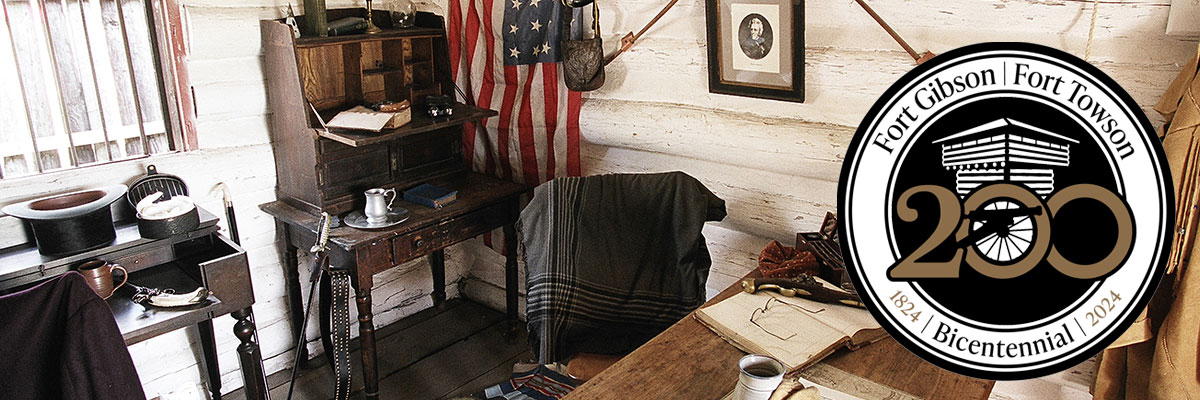
Fort Gibson Historic Site
Fort Gibson Historic Site
907 North Garrison Avenue
Fort Gibson, OK 74434
918-478-4088
fortgibson@history.ok.gov
Director: Jennifer Frazee
Historical Interpreter: Darren Vermillion
Construction/Maintenance: Rory Montgomery
Museum Hours
Tuesday through Saturday
10 a.m. to 4:30 p.m.
| Adults | $7 |
| Seniors (62+) | $5 |
| Students (6–18) | $4 |
| Family (up to 6 people) | $18 |
| Group Rate (10+) | $5/person |
| OHS Members, Children (under 6), Veterans and Active Military (with ID) | Free |


Adjusted Hours at Fort Gibson Historic Site
April 17 and 18 - Closed to prepare for for anniversary events
April 19 - Education Day, open to school groups only
Fort Gibson Commemorates 200 Years
Fort Gibson Historic Site will mark 200 years with Spring Bake Day in March, the annual Education Day event in April, and a 200th Anniversary Commemoration on Saturday, April 20. The town of Fort Gibson will mark the anniversary with a community parade that will end at the historic site. After the parade, OHS staff will begin bicentennial programming and honor the occasion with addresses from dignitaries. Visitors can partake of cake and refreshments in the mess hall and tour the grounds, which consist of 80 acres and several historic structures and outbuildings.
Education stations will include living historians conducting demonstrations about 19th-century foodways, weaponry, and civilian and soldier life. Many reenactors will be camping at the fort all weekend, and Neosho River walking tours will include viewing a replica 19th-century keelboat docked at the riverside where supplies and people were ferried along water highways.
Visit Fort Gibson
Visitors can see a reconstruction of the early log fort and the stockade, as well as original buildings from the 1840s–70s. Exhibits exploring the fort’s history are located in the Commissary Visitor Center on Garrison Hill. Fort Gibson Historic Site hosts special living history events, Bake Days using the historic bakehouse, and educational programs throughout the year.
The site features a log stockade reconstructed under the Works Progress Administration 1937. The structure underwent extensive restoration beginning in 2013 and reopened to the public in 2016. Fort Gibson is a National Historic Landmark and is listed in the National Register of Historic Places.
The History of Fort Gibson
Fort Gibson served a pivotal role in the political, social, and economic upheaval that marked the westward expansion of the United States.
Built at the critical crossroads of the Three Forks where the Arkansas, Verdigris, and Grand Rivers converge south of the Ozark Plateau, Fort Gibson was key to river navigation. It also served as an outpost on the Texas Road connecting settled Missouri with the new country of Mexico after independence from Spain in 1820.
Fort Gibson was established in 1824 to keep the peace between the Osages and Cherokees. It figured prominently in the Indian removals and was home to many of our nation’s leaders during the 1840s and 1850s. Fort Gibson served as a starting point for several military expeditions that explored the West. It was occupied through most of the Indian removal period, but then abandoned in 1857. The post was reactivated during the Civil War. It was renamed Fort Blunt and served as the Union headquarters in Indian Territory. The army stayed through the Reconstruction and Indian Wars periods, combating the problem of outlaws and squatters.
Abandoned in 1890, the fort was later the headquarters of the Dawes Commission for their work enrolling members of the Five Tribes. At Fort Gibson, the Commission members focused their attention on Cherokee Freedmen.
Visit The Encyclopedia of Oklahoma History and Culture to find out more about Fort Gibson.
Fort Gibson featured in Crossroads

Issue seven of Crossroads takes a look at the Civil War–era oven and the history of Fort Gibson.
Find out more.

Operating support is generously provided by the Cherokee Nation.

